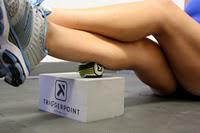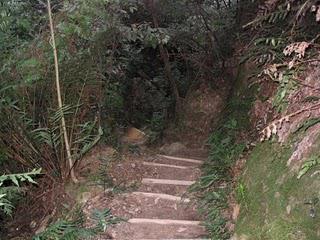 The injury is not typically felt until 24-48 hours after the session (hence the delayed onset part of its name). I train quite a bit, mostly running with some other strength exercises too, so DOMS is uncommon for me, however this week it has taken me out of action for a couple of days and been a real wake up call.
The injury is not typically felt until 24-48 hours after the session (hence the delayed onset part of its name). I train quite a bit, mostly running with some other strength exercises too, so DOMS is uncommon for me, however this week it has taken me out of action for a couple of days and been a real wake up call.The reason behind it was a short sharp stair climbing session on Friday. It consisted of running up about 150m vertical of stairs 10 times, which was taking about 2 minutes per repetition. I’ve done this session before (although only 8 reps, and with a much longer warm up/down) and the only problem then has been that it’s bloody hard! This was no exception as by the 7th set I was feeling pretty dizzy and weak. Still I finished the session and that was the end of it.
The following day I had an LSD planned, so went out (in the rain again!) and ran 40kms on the hills and trails around my home in about 4 hours 30mins. No problems there as it was pretty cruisey.
Getting out of bed on Sunday morning I had a bit of a shock as it was a struggle to stand up as my calves felt like they were in a vice and were very tender to the touch. I knew immediately that this was DOMS and that the effects normally only last for about 24 hours so I would just ride it out. The rest of my body was completely normal and seemingly unaffected.

Not my legs I must mention!
Today however I was only marginally better and thought that running would not be advisable. So I have spent the evening sitting on the floor in front of the TV doing some gentle, but persistent massage to my troubled calves using my TP Therapy balls (I’ll write more on these in another post).The trouble is that all the best advice on DOMS it that there is little you can do to speed recovery (according to Tim Noakes’ running bible – The Lore of Running). What I do is make sure that I am drinking plenty of fluids to flush out the waste products of the damaged muscles and to eat plenty of the right foods (good quality protein and food rich in antioxidants) to aid the muscle regeneration process.
The thing that really hit me was the severity of this bout of DOMS. Basically as I was running up these stairs my entire weight was being loaded onto each calf individually as only my toes were in contact with the steps. Normally when doing my hills sessions and running on the trails, my entire foot takes the load sharing the weight across all the muscles of the lower leg. This subtle difference in training has had a massive impact on my performance, unfortunately a negative one (as the effects can take around 2-3 weeks to fully recover).

Just a very short taste of what is in store
The reassuring thing I keep in mind is that in my next race, the North Face 100, which has too many stairs to mention, the steps are quite different. They are fashioned from logs and rocks, and typically you can get you entire foot on the step. If last year is anything to go by I will be putting both feet on each step as it is a long day at the office. So hopefully I will not be putting myself in the situation I am now.At the same time is reminds me of the need for specificity in your training. Being aware of the terrain and conditions of the course you are going to be running, enables you to prepare your body as best you can for what lies ahead – without putting up with many days of discomfort (especially when you may have to drive home the following day!). So with that in mind I will be doing more on the stairs, and probably a bit more on the weights to focus on this weaker area. Although I know that the next race will not be as demanding as the trauma I inflicted on my calves, there is a potential weakness that needs addressing.
Ultrarunning is one of the disciplines where you most certainly are only as strong as your weakest link.
Run Happy
Andy
“What counts in battle is what you do when the pain sets in” – John Short
***Please support my 33 Marathons Challenge***
www.ultrarunning.com.au

